Imagine, if you will, a mosaic.
Continue reading Mosaics, Metaphors, Monuments: Hochelaga Rock in Imaginary Perspective
Imagine, if you will, a mosaic.
Continue reading Mosaics, Metaphors, Monuments: Hochelaga Rock in Imaginary Perspective
The old Lachine is celebrated for the beauty of its historical buildings and of the natural landscape at the end of the St-Louis Lake and the beginning of the rapids. For this post, I concentrated my efforts in highlighting the fact that Lachine, one of the boroughs of the west of the city of Montreal, was constructed and populated with different activities relying on colonial relations primarily with Indigenous people.
Contact:
The western history of what we now call Lachine starts with travels of Jacques Cartier (1535) and Samuel de Champlain (1603). The main feature of the territory for both explorers is the terrible rapids that block the route towards the West. The Grand Sault, as Cartier calls it, or the Sault Saint-Louis for Champlain, is a critical landmark for both Europeans and Indigenous people.
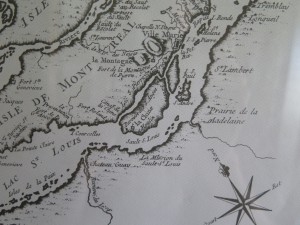
The most western point of those rapids, the site of my interest in this work, rapidly becomes a privileged point of meeting for colonizers and their commercial partners. This point is crucial for strategical reasons. What archeologists call site BiFk-6 is a hill at the confluent of the Saint-Pierre River, the rapids and the Saint-Louis Lake that is easily recognisable, thus ideal as a commercial point. Indigenous people knew of this site long before Champlain dreamt of using it. Artifacts predating by more than 400 years the arrival of Cartier were found on the hill (Buteau and Chevrier 2001, 16).
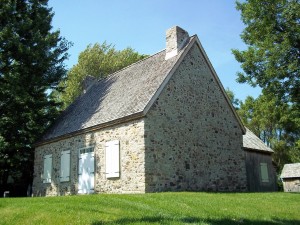
Another proof of the use of this site pre-contact comes from Champlain. In the accounts of his travels, the 4th to be exact (1613), Champlain, through a conversation with Tessouat, chief of the Kichesipirini, delivers some crucial information about the status of the future Lachine. Speaking with his host on L’Ile-aux-allumettes at the modern-day border of Quebec and Ontario, he asks why does his people try to cultivate such an inhospitable land while better lands like the one near the Sault Saint-Louis were “deserted and abandoned”. Tessouat answers that the unattractiveness of his lands makes it safer to live on and that if the French were to build a fortification, as they promised, he would consider moving there, assured that his enemies would not attack (Champlain 1908, 191). From this exert, we can understand that this land was known outside of the Iroquoians to which the Island of Montreal is usually associated to since the Kichesipirini passed through.
Name:
I also want to underline that colonial history is also topographical and connected to the writings of the colonial power. The oldest name we know today for the site I am investigating was given by Europeans. I was unable with my research to find the name used by any Nation to designate Lachine. Prior to its modern name, Lachine had been called Sault Saint-Louis in correspondence to the rapids and then Côte Saint-Sulpice in honor of the religious group, the Sulpician, who had claimed the Island of Montreal as theirs. The name Lachine alludes to another aspect of the colonial history of the Americas. As we all know, Europeans set sail westward I hopes of finding China through the sea since the Ottoman had taken control of Constantinople. Even after finding North America and acknowledging that it was not Asia, some explorers were still obsessed with finding the route to China. It is the case of Robert Cavelier de LaSalle who obtained the Seigneurie from the Sulpician. His many travels down the Mississippi in hopes of finding China were becoming so famously a failure that the settlers on his lands began to call the Seigneurie La Chine (literally China) to mock the explorer. The name then becomes another embodiment of the commercial colonialism of the Europeans.
Lachine Massacre:
While Lachine started as a meeting point between the French and the Algonquin people, it rapidly became a settler village as I just mentioned, the first arriving in 1667. The Seigneurie consisted in three fortification of wood across a territory that spanned from the modern day border of Pointe-Claire and Dorval to the one between LaSalle and Verdun. In 1689 happened an event that became a deep traumatic experience for the people of Lachine. The memory of this event carried on into the 20th century. The commission of the historical site and monuments of Canada erected in 1935 a small monument with a plaque to commemorate this tragic event. On it can be read information taken from a letter of Governor Frontenac reporting that in the dead of night, Iroquois warriors attacked and burned all the residences of the Lachine Seigneurie killing 200 people and abducting 120 (Parkman 2005, 113).

This plaque is problematic in many ways. What this monument and Frontenac fail to say is that the reality was closer to 24 deaths and 60 prisoners and that this attack (Moussette 1978, 44). Also, this event occurred in the context of the French and Iroquois wars encouraged by the British. If French settlers and authorities were allied to the Algonquin, the British were allied to the Iroquois. A peace treaty signed between the French and the Iroquois in 1667 calmed the relations in New France for 20 years. The situation deteriorated following two events. The first one occurred in 1687. At the demand of a new Naval Minister in France, the Governor of New France broke the peace and prepared a trap for the Onnontagués Iroquois by inviting them to some festivities at Fort Frontenac where they were imprisoned and some sent to the King’s galleys (Moussette 1978, 44). The other event is the Glorious Revolution in England that chased James II, ally of Louis XIV, shifting the relation with France in Europe and in America. In short, the attack on Lachine was not an act of pure cruelty but a response to a direct attack on a part of the Haudenosaunee Confederation and it was encouraged by a change in alliances. Factual information is not the only problem about this plaque. Two medallions are decorating the upper part on the right depicting men working in what looks like a dock and the other on the right depicts “Indians” in the wood, naked except for the feathers on their head looking at a 17th century ship on a river that we guess is the St. Lawrence.
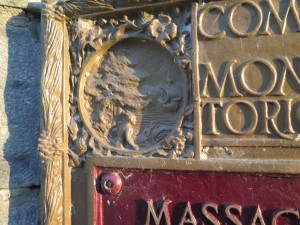

This representation is problematic like many others we seen in America because it reinforces this opposition between Nature and Culture, present and past. It also creates a devise that is particular to Lachine. Because of the context of the Lachine Massacre, we assume the Indigenous men we are seeing are Iroquois and because of Kahnawà:ke being so near, we associate them more precisely with Mohawks. This association is dangerous because it damages the relationships between modern day settler descendants and Mohawk people. The medallion depicts these men of the 17th century looking at the other side of the river creating this image that Mohawk people are still in this “primitive state” and that they are still a threat to the inhabitant of the other side of the river.
Fur trade official site:
As a transitionary space between the St. Lawrence valley and the Pays d’en haut, Lachine quickly became a pivotal point in the fur trade. Already a key geographical point in the meeting between French and Algonquin, it became an official commercial point with the construction of a hangar by the North West company in 1803.

The economy of the small village relied on the fur trade. Taverns and hostels were built to accommodate the travelers who would come and go with the seasons. The competition raged between the Scottish North West Company and the English Hudson Bay Company. Following the annexation of the NWC by the HBC in 1821, Sir George Simpson, General Governor of the HBC, built a mansion in Lachine to assess his power over the fur trade. Rarely present in this residence, he left the manor to his second, Edward Hopkins and his wife the painter Frances Ann Hopkins. Thanks to her depictions of the fur trade, we know that indigenous people stayed an important part of the commerce well into the 19th century. As a side note, it is in this Manor that the Hopkins and Sir Simpson received the Prince of Whales in 1860.
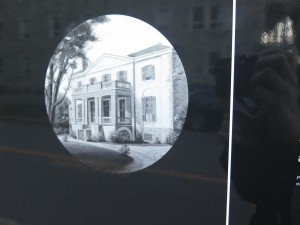
Lachine Canal:
Between the manor and the hangar lies the Lachine Canal dug between 1821 and 1825, then enlarged from 1843 to 1848. As the 19th century progressed, the economy of the canal passed from fur to industrial goods. One of those resources passing through was sugar coming from the Caribbean. Ending in the Redpath refinery in Pointe-Saint-Charles or in the molasses factory in Faubourg à m’lasse, it is important to mention that Canada passed from a resource colony to an actor in economical colonialism outside of its borders.
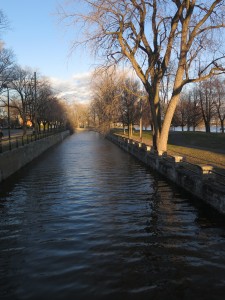
Missionary site:
At the death of Sir George Simpson, Les Soeurs de Sainte-Anne, a religious order founded in 1850 in Vaudreuil, bought the manor and used it as a convent and as an all-female boarding school. The establishment of this group in what we call today the Old Lachine was the start of the population movement from the rural areas around the Seigneurie towards a “downtown” Lachine.

It is also from this Mother-house that Sisters left on evangelisation missions to British Columbia (1858), U.S.A. (1867), Alaska (1886), Japan (1934), Haiti (1944), Chile (1965) and Cameroun (1968). In Canada, the sisters established schools in Quebec and BC. Arriving in Vancouver in 1858, they were the first missionaries in the West and participated to the establishment of the first schools and hospitals. Their involvement in the education of the indigenous youth was inscribed in the evangelisation frame that has characterised the history of education in Canada but they took great pride in giving good education to white and indigenous girls in B.C. Later, with the Indian Act, they participated in two schools that were part of the Residential school system, one of them being in Kamloops (TRC 2016, 692). In parallel, they continued to give classes in non residential schools in B.C. and Quebec.
In conclusion, my goal was not to only show the darker sides of the history of Lachine but to try to write a nuanced version of a history that is usually euro-centric. Only by knowing and understanding the imbalances in the colonial power can we hope to decolonize the relationships we have with the first people and non-western immigrants.
Bibliography:
Buteau, Hélène and Daniel Chevrier. 2001. D’audace en mémoire : Le lieu dit Lachine, un regard archéologique, Collection In Situ. Montréal : Art Gestion Inc.
De Champlain, Samuel. 1908. Les Voyages de Samuel de Champlain au Canada 1603-1618. Québec: Édition populaire.
De Champlain, Samuel. 2009. À la rencontre des Algonquins et des Hurons 1612-1619. text in modern french annotated and presented by Éric Thierry. Collection V. Québec : Éditions du Septentrion.
Moussette, Normand. 1978. En ces lieux que l’on nomma “La Chine”…. Lachine : Ville de Lachine.
Parkman, Francis. 2005. Count Frontenac and New France under Louis XIV. Raleigh: Hayes Barton Press.
Truth and Reconciliation Commission of Canada. 2016. Canada’s Residential Schools : The History, Part 1, Origins to 1939. Montreal; Kingston : McGill-Queen’s Press.
Otter Lake (Lac à la Loutre), also known as little St-Pierre Lake, fed into the St-Pierre River flowing to the St Lawrence River. The lake has now disappeared and can only be heard underneath the city through the sewers. The Lake spanned almost seven kilometres, its width at certain points being up to one kilometre, and covered the areas that are now Ville St. Pierre, Montreal West, Nôtre-Dame-de-Grace, St. Henri and Atwater. The name of this lake is said to have come from the Indigenous populations who surrounded it in reference to its shape, that of a baby otter inside a larger otter shape (the island of Montreal). The Iroquois cultivated the shores of the lake but with the arrival of the French and the fur trade in the 17th century the lake became used more and more for coureurs and voyageurs.
This projects aim was to follow the shores of this mysterious lake and document the sights and sounds. Through this experience we can see and hear what exists in these locations today.
There is so much mystery surrounding the exact location of Otter Lake and throughout my research I was only able to find certain points where the lake was known to be located. My goal was to see what this lake looks like today in all the points where I know the lake used to be. Initially I wanted to follow the shoreline but this was difficult due to the mystery surrounding the exact location of the lake as a whole and also the construction happening over many areas that the lake covered. So I mapped different points I found in my research and went to discover all those points. It was through this journey of exploring areas that was I able to rediscover parts of this forgotten lake in the present.
Video #1: Parc du Lac-a-la-Loutre
This park is an homage to Otter Lake, a lake that was completely lost due to the development of the City and the Lachine Canal. It is said that the park now rests on top of where part of the lake used to be. This park is the only remaining reference to the lost lake that spanned about seven kilometres from Ville St. Pierre through Notre Dame de Grace and St Henri and was one kilometre wide at its widest point.
Video #2: Parc du Lac-a-la-Loutre Fence
The fence of the park follows the shoreline of the forgotten lake. There is a lot of mystery around where the lakeshore was exactly located, this is the only point that is certain. This park is located at the corner of Courcelle and Saint-Ambroise.
Video #3: Underneath the Turcot Exchange Wide
Part of Otter Lake is known to have been right under the Turcot Interchange. It followed the railway tracks closely around this location and right around here is the point that the trains crossed the lake on their way to Lachine.
Video #4: Underneath the Turcot Interchange Close
The crumbling Turcot Exchange looms over the location of the former lake. The lake was filled using the dirt excavated for the Lachine Canal that would be an easier was of crossing the island.
Video #5: View Across Highway 20
As cars drive along this stretch of Highway 20 their view on one side are the Turcot Yards. This is where a large part of the lake was before it was filled up. Accessing this area is difficult. This view shows what exists now on what was probably the shore or edges of the lake. We can see the big piles of earth showing the constant construction happening in the area. Imagine standing here and seeing a green swamp and lake.
Video #6: View of Turcot Yards from Above
Trying to get many different views of the Turcot Yards is a difficult task. There are so many things blocking access and a view of the area whether it is the highway, fences, walls, or trees. Here it is from above along Rue Saint-Jacques, through the many trees that block the view.
Video #7: The Turcot Yards
The Turcot Yards are directly above where Otter Lake used to be. The ground was raised six feet since the days of Otter Lake and construction continues due to the ground not being solid. There have been debates about how to use this abandoned area. There are many who have begun arguing that the lake ought to be brought back.
Video #8: Saint-Pierre Exchange
This is the location where Otter Lake ended and it is now known as the St-Pierre Exchange where construction often closes the different parts of the interchange and keeps being delayed.
Video #9: Lachine Canal
The Lachine Canal runs close and at times intersects with the location of the former lake. Due to the shallow and swamp-like nature of the lake it was covered up to make way for the canal that would be a sure way of moving through the island easily. The land that was dug up to make the canal was used to cover up the lake. Now with these debates about bringing Otter Lake back they are saying that water from the canal would be used to fill the lake.
Many people do not know that this lake even existed, let alone the Indigenous presence that surrounded it. The land we live on has a history that so many are unaware of, even histories that are below the surface and hidden.
The site for our intervention is the Hochelaga National Historic Site of Canada, located in downtown Montreal and situated on McGill University. Our first goal is to create a clear and accessible path to the Hochelaga Rock. Furthermore, we wish to install a rotating art exhibition within the immediate vicinity that changes with the seasons. We often see the aboriginal community marginalized and their culture placed in opposition to the metropolitan norm. Our mandate is to address this and also focus on bringing attention to the historical site itself while also raising awareness on Indigenous contemporary culture. Our hope is to highlight, encourage, and expose aboriginal culture and heritage within the landscape of our modern society.
The Hochelaga Rock, its neglect, and its inaccessibility bring into question our societies neglect of aboriginal heritage and history. We live in a society that is historically founded on individuals who were forced from their homes and land, yet we fail to recognize or give credence to those who are now for the most part marginalized from society. We hope to give the aboriginal community a voice in claiming back their space and what once existed on the island of Montreal.
Kanien’keha:ka Onwawen:na Raotitiohka Language and Cultural Centre:
http://www.korkahnawake.org/
Jaime Black, The REDress Project:
http://www.theredressproject.org/
Ryan Rice, “Oh So Iroquois”:
https://www.amazon.ca/Kwah-ken-Tsi-Iroquois-Tellement/dp/1894906292